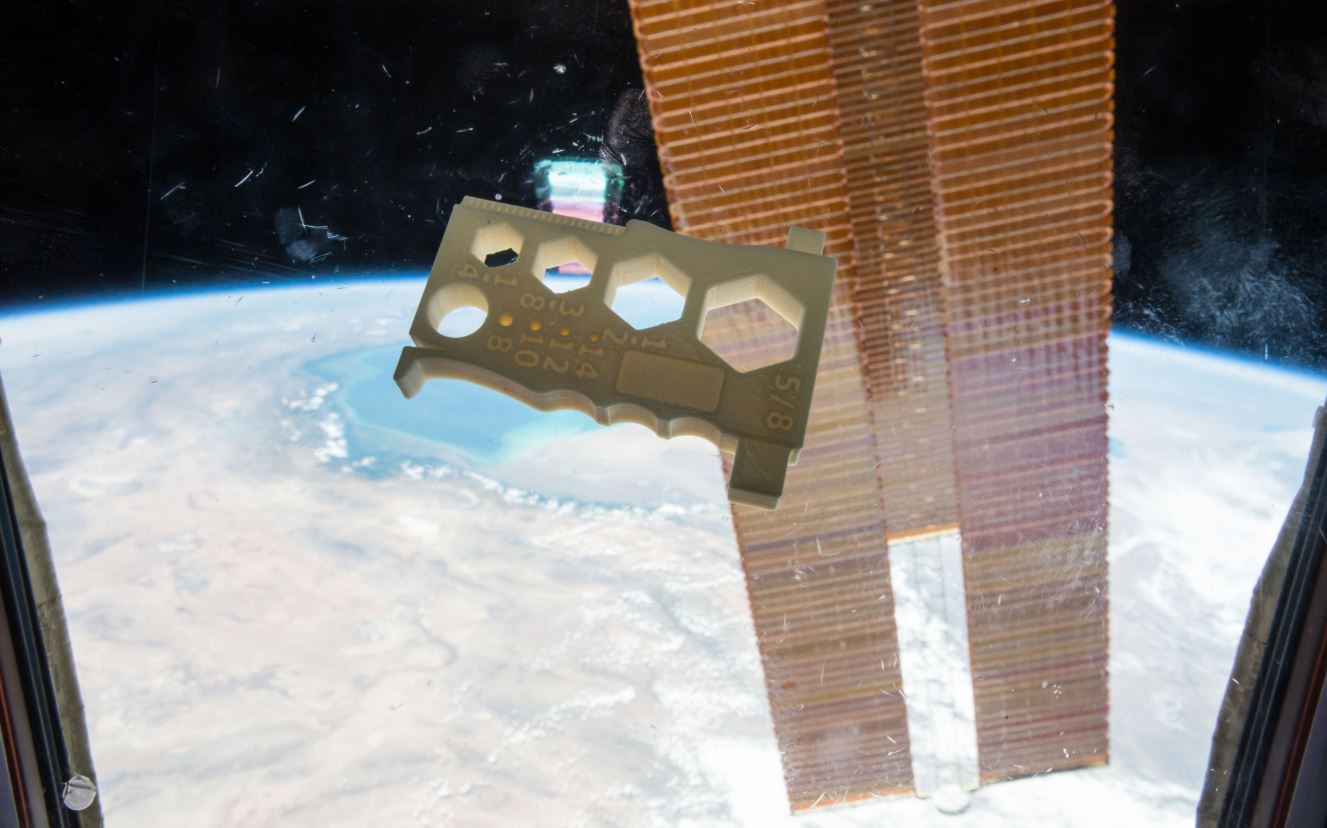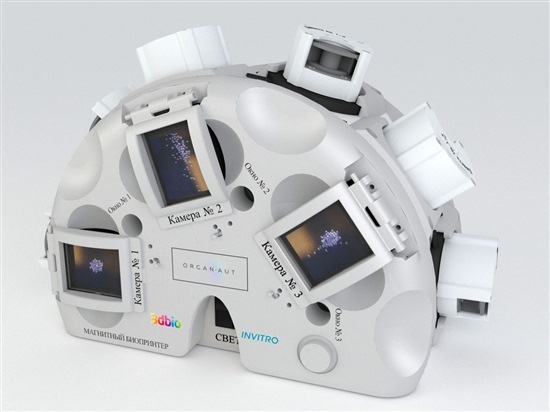

News
First living tissue 3D printed in space aboard International Space Station
Using the “Organaut”, a 3D bioprinter designed for microgravity, Russia has become the first country to print living tissue in space. After a December 3rd cargo delivery to the International Space Station (ISS), cosmonaut Oleg Kononenko completed an experiment with the machine in the Russian sector of the station, successfully producing human cartilage tissue and a rodent thyroid gland. The Organaut was designed via a collaboration with the printer’s maker, 3D Bioprinting Solutions, and Russia’s national space agency, Roscosmos. The United States also has its own bioprinting mission scheduled for the first half of 2019, joining in the march to develop biological solutions for problems that space is well suited to solve.
A 3D bioprinter operates by creating one layer at a time of specified tissue or stem cell material arranged as needed to grow and form as biologically programmed to do. As summarized by Aryeh Batt, the CEO of Precise Bio, a company dedicated to 3D printed bioproducts for human eyes, “Essentially, the biology does the work, but you have to put them in the correct environment to make it happen.” In the case of Organaut, an internal robotic mechanism drips living cell fabric layers from an automatic syringe. When living tissue is bioprinted under Earth’s gravity, the artificial cells grow in a flatter structure than their natural state in the human body. In microgravity, however, they form a shape closer to their normal dimensions.
Along with demonstrating the growth advantages of microgravity, Organaut’s tissue samples will provide the ability to study the effect of radiation on the body. “We will look at how the constructs came together, and how they behaved,” confirmed Usef Hesuani, head of laboratory projects and a managing partner of 3D Bioprinting Solutions in a recent press conference. The original Organaut printer was aboard the Soyuz MS-10 spacecraft which experienced an launch failure on October 11, 2018, forcing the U.S. and Russian crew to make an emergency landing. A second one was quickly put together for the subsequent mission.

The parent company of 3D Bioprinting Solutions is INVITRO, the largest private medical company in Russia. Founded in 1995 by Aleksandr Ostrovsky, it has 8 laboratories and over 1000 medical offices in eastern Europe, but is primarily based in Skolkovo, a high technology business area in Moscow. Bioprinting Solutions made headlines in 2015 when it printed and transplanted a functioning mouse thyroid gland. The experiment performed aboard the ISS with Organaut was a modified version of their prior work.
Unlike NASA, Roscosmos does not generally partner with private companies for its research endeavors. In an effort to inspire Russian students to enter STEM fields within their country, the agency sought to spotlight the developing bioprinting industry by using the Organaut. The successful partnership with 3D Bioprinting Solutions has now motivated the agency to continue partnering with private companies in the future. The company itself also sees advantages to collaborations of its own with other Skolkova-area manufacturers. “We have companies that are making satellite platforms…it is possible to conduct a similar experiment amid microgravity on small spacecraft [like satellites]…smaller and cheaper,” noted Ivan Kosenkov, 3D Bioprinting Solutions’ project manager.
Organaut’s printed tissues were returned to Earth with the Soyuz MS-09 spacecraft on December 20th, and the results of the experiment are expected to be published at the end of January 2019. In February, NASA plans to send a bioprinter capable of producing beating heart tissue to the ISS. Named the 3D BioFabrication Facility (BFF), the machine was developed through a partnership with two companies well-established in 3D printing and on-orbit hardware, nScrypt and Techshot. Since the thickness of heart tissue is difficult to build under gravity without structural assistance that could impede functionality, the companies developed the BFF with the hypothesis that microgravity would overcome this limitation. Thus far, the concept has been proven during parabolic flight tests, i.e., aboard the “Vomit Comet” airplane that performs multiple parabolic maneuvers in an airliner to create 20-30 seconds of weightlessness each.

News
Tesla aims to combat common Full Self-Driving problem with new patent
Tesla writes in the patent that its autonomous and semi-autonomous vehicles are heavily reliant on camera systems to navigate and interact with their environment.

Tesla is aiming to combat a common Full Self-Driving problem with a new patent.
One issue with Tesla’s vision-based approach is that sunlight glare can become a troublesome element of everyday travel. Full Self-Driving is certainly an amazing technology, but there are still things Tesla is aiming to figure out with its development.
Unfortunately, it is extremely difficult to get around this issue, and even humans need ways to combat it when they’re driving, as we commonly use sunglasses or sun visors to give us better visibility.
Cameras obviously do not have these ways to fight sunglare, but a new patent Tesla recently had published aims to fight this through a “glare shield.”
Tesla writes in the patent that its autonomous and semi-autonomous vehicles are heavily reliant on camera systems to navigate and interact with their environment.

The ability to see surroundings is crucial for accurate performance, and glare is one element of interference that has yet to be confronted.
Tesla described the patent, which will utilize “a textured surface composed of an array of micro-cones, or cone-shaped formations, which serve to scatter incident light in various directions, thereby reducing glare and improving camera vision.”

The patent was first spotted by Not a Tesla App.
The design of the micro-cones is the first element of the puzzle to fight the excess glare. The patent says they are “optimized in size, angle, and orientation to minimize Total Hemispherical Reflectance (THR) and reflection penalty, enhancing the camera’s ability to accurately interpret visual data.”
Additionally, there is an electromechanical system for dynamic orientation adjustment, which will allow the micro-cones to move based on the angle of external light sources.
This is not the only thing Tesla is mulling to resolve issues with sunlight glare, as it has also worked on two other ways to combat the problem. One thing the company has discussed is a direct photon count.
CEO Elon Musk said during the Q2 Earnings Call:
“We use an approach which is direct photon count. When you see a processed image, so the image that goes from the sort of photon counter — the silicon photon counter — that then goes through a digital signal processor or image signal processor, that’s normally what happens. And then the image that you see looks all washed out, because if you point the camera at the sun, the post-processing of the photon counting washes things out.”
Future Hardware iterations, like Hardware 5 and Hardware 6, could also integrate better solutions for the sunglare issue, such as neutral density filters or heated lenses, aiming to solve glare more effectively.
Elon Musk
Delaware Supreme Court reinstates Elon Musk’s 2018 Tesla CEO pay package
The unanimous decision criticized the prior total rescission as “improper and inequitable,” arguing that it left Musk uncompensated for six years of transformative leadership at Tesla.

The Delaware Supreme Court has overturned a lower court ruling, reinstating Elon Musk’s 2018 compensation package originally valued at $56 billion but now worth approximately $139 billion due to Tesla’s soaring stock price.
The unanimous decision criticized the prior total rescission as “improper and inequitable,” arguing that it left Musk uncompensated for six years of transformative leadership at Tesla. Musk quickly celebrated the outcome on X, stating that he felt “vindicated.” He also shared his gratitude to TSLA shareholders.
Delaware Supreme Court makes a decision
In a 49-page ruling Friday, the Delaware Supreme Court reversed Chancellor Kathaleen McCormick’s 2024 decision that voided the 2018 package over alleged board conflicts and inadequate shareholder disclosures. The high court acknowledged varying views on liability but agreed rescission was excessive, stating it “leaves Musk uncompensated for his time and efforts over a period of six years.”
The 2018 plan granted Musk options on about 304 million shares upon hitting aggressive milestones, all of which were achieved ahead of time. Shareholders overwhelmingly approved it initially in 2018 and ratified it once again in 2024 after the Delaware lower court struck it down. The case against Musk’s 2018 pay package was filed by plaintiff Richard Tornetta, who held just nine shares when the compensation plan was approved.
A hard-fought victory
As noted in a Reuters report, Tesla’s win avoids a potential $26 billion earnings hit from replacing the award at current prices. Tesla, now Texas-incorporated, had hedged with interim plans, including a November 2025 shareholder-approved package potentially worth $878 billion tied to Robotaxi and Optimus goals and other extremely aggressive operational milestones.
The saga surrounding Elon Musk’s 2018 pay package ultimately damaged Delaware’s corporate appeal, prompting a number of high-profile firms, such as Dropbox, Roblox, Trade Desk, and Coinbase, to follow Tesla’s exodus out of the state. What added more fuel to the issue was the fact that Tornetta’s legal team, following the lower court’s 2024 decision, demanded a fee request of more than $5.1 billion worth of TSLA stock, which was equal to an hourly rate of over $200,000.
Delaware Supreme Court Elon Musk 2018 Pay Package by Simon Alvarez
News
Tesla Cybercab tests are going on overdrive with production-ready units
Tesla is ramping its real-world tests of the Cybercab, with multiple sightings of the vehicle being reported across social media this week.

Tesla is ramping its real-world tests of the Cybercab, with multiple sightings of the autonomous two-seater being reported across social media this week. Based on videos of the vehicle that have been shared online, it appears that Cybercab tests are underway across multiple states.
Recent Cybercab sightings
Reports of Cybercab tests have ramped this week, with a vehicle that looked like a production-ready prototype being spotted at Apple’s Visitor Center in California. The vehicle in this sighting was interesting as it was equipped with a steering wheel. The vehicle also featured some changes to the design of its brake lights.
The Cybercab was also filmed testing at the Fremont factory’s test track, which also seemed to involve a vehicle that looked production-ready. This also seemed to be the case for a Cybercab that was spotted in Austin, Texas, which happened to be undergoing real-world tests. Overall, these sightings suggest that Cybercab testing is fully underway, and the vehicle is really moving towards production.
Production design all but finalized?
Recently, a near-production-ready Cybercab was showcased at Tesla’s Santana Row showroom in San Jose. The vehicle was equipped with frameless windows, dual windshield wipers, powered butterfly door struts, an extended front splitter, an updated lightbar, new wheel covers, and a license plate bracket. Interior updates include redesigned dash/door panels, refined seats with center cupholders, updated carpet, and what appeared to be improved legroom.
There seems to be a pretty good chance that the Cybercab’s design has been all but finalized, at least considering Elon Musk’s comments at the 2025 Annual Shareholder Meeting. During the event, Musk confirmed that the vehicle will enter production around April 2026, and its production targets will be quite ambitious.








